Redundant/Duplicate Publications
Submissions
Author Guidelines
1. Purpose and Scope
The Davao Research Journal is a multidisciplinary and peer-reviewed journal that publishes research and developmental reports in various fields of study. It is the official journal of the Davao Oriental State University (DOrSU). However, contributors from other institutions, universities, and agencies, including foreign authors, are also welcome to submit their manuscripts. The journal is published quarterly, depending on the availability of reviewed reports in an acceptable form. The scope of the journal includes, but is not limited to, the following areas of research:
- Agriculture
- Life Sciences
- Environmental Science
- Fisheries
- Linguistics
- Pedagogy and Education
- Social Sciences and Humanities
2. Types of articles accepted for publication
Manuscripts submitted to DRJ are reports from an original study that has not been published or submitted simultaneously elsewhere for publication, except as an abstract for oral or poster presentation.
- Original research articles are manuscripts that present a novel contribution to the development of an area of research. Ideally, manuscripts should have a maximum of 7,000 words.
- Review articles are intended to provide a detailed and exhaustive overview of a selected topic, a perspective on the state of the field, and its implications. Leaders often write them in a particular discipline after an invitation from the editors of a journal. Reviews commonly cite at least 50 primary research articles and ideally should not exceed 9,000 words (excluding the list of references).
- Research notes are short reports on high-impact results with significant observations that do not warrant full-length papers. Notes must have considerable potential significance for a broad readership that will likely stimulate further research in the field. They should not exceed 3,000 words and ideally must have two tables and two figures.
- Policy briefs present a concise summary of a particular issue that can help readers understand and likely make decisions about government policies. Policy briefs may give recommendations on the best policy option based on summaries of relevant research, or even further argue for particular courses of action for government policymakers and others who are interested in formulating or influencing policies. Policy briefs should be 1,500 words and augmented with two tables or two figures.
- Letters and commentaries offer writers an opportunity to present their critical observations on current professional issues, social problems, or policy matters. Submissions are expected to build on existing literature about the topic. The maximum length of the manuscript should not exceed 1,000 words.
- Viewpoints provide readers an opportunity to respond substantively to an article previously published in DRJ and to challenge the results or positions in that article. Such papers intend to stimulate dialogue within the profession. The Editor-in-Chief reviews such manuscripts anonymously. If a manuscript is accepted, the author of the original article will be asked to respond to the viewpoints expressed in it. If the original author declines to answer, a manuscript may be shortened and included as a Letter to the Editor. The maximum length of the manuscript should not exceed 1,000 words.
- Editorials are opinion articles written by the editors of DRJ about essential issues concerning science or social science, particularly its interface with broader society. Sometimes, these Editorials announce and describe a new or amended editorial policy. Ideally, the manuscript should not exceed 500 words.
3. Submission of Manuscript
Submission of a manuscript implies that the work described has not been published before, is not under consideration for publication anywhere else, and its publication has been approved by all co-authors, as well as by the responsible authorities at the institution where the work has been carried out. Manuscripts should be submitted online through the DRJ website or emailed directly to the Editor-in-Chief as an attachment. All submitting authors should use the IMRAD format, follow a double-spaced manuscript formatting, and use APA for citation, including the use of tables, statistics, and designing figures. Once received, all manuscripts will be subjected to a double-blind peer review process by two or more experts in the field.
email: editor.drj@dorsu.edu.ph
The review process will include plagiarism detection to assess the originality of the submitted manuscripts. The Editor-in-Chief retains the right to reject a manuscript without review or any submission that shows significant overlap with existing databases of published scholarly works.
4. Permissions
Authors wishing to include figures, tables, or text passages that have already been published elsewhere are required to obtain permission from the copyright owner(s) for both the print and online format and to include evidence that such permission has been granted when submitting their papers. Any material you receive without such evidence will be assumed to be from the authors.
5. Manuscript Preparation
Authors are encouraged to read and download the latest sample articles at the Davao Research Journal website at the davaoresearchjournal.ph when preparing their manuscript. The required layout uses a 1-inch margin on all sides, must use letter size, serif font style of 12-point Times New Roman.
Text Formatting
- Manuscripts should be submitted in a Word file.
- Use italics for scientific names and sparingly on local terms for emphasis.
- Use the spreadsheet for making your tables and then insert it inside a two-row table. The above row should be used to insert the table number and table title, while the other row will be used to paste the spreadsheet from Excel to make the tables.
- Use the equation editor or Math Type for equations.
- Do not use vertical bars in any of the tables, and use three horizontal lines for the table at most; two for the heading rows and one horizontal line for the end row. But in the case of multiple or long tables, you can add more horizontal lines every three or four rows.
- Abbreviations should be defined at first mention and used consistently thereafter. Example: HYV for high-yielding variety, ANOVA for analysis of variance.
- For scientific names, they should be spelled entirely in the different sections of the paper, but shorten the italicized genus name to the first capital letter, followed by the species name the second time they are mentioned in the section of the paper.
- Papers should be written in English, except if the paper needs to include local names or terminologies, like the study of a local or national language other than English.
- Use SI units and symbols. Use exponents instead of a slash (ex., m s-1). All scientific units must be preceded by a space, for example: ‘... for 2.5 h at 50 °C’ and not ‘... for 2.5h at 50°C’.
- Authors are required to include line numbering in their text file; the line numbering should be continuous on all pages.
- Save your file in docx format instead of doc or pdf formats.
- Manuscript should be spell-checked and grammar-checked before submission to avoid trivial errors.
- Texts should be justified.
- Indent the first line of every paragraph.
- Always use double space except in the abstract, where single space is used.
- Keywords must use up to five words, excluding words already used in the title or abstract.
- All references should follow the latest APA style of citation.
Title page
The title page should include:
- A clear, concise, and informative title that reflects the content or result of the manuscript and ideally, should not exceed 15 words.
- Authors are those who have made substantial intellectual contributions to the research work, not just those who provided laboratory access or funding to the project. In case of multiple authorship, one author must be designated as the “Corresponding Author” with an asterisk. The corresponding author is the person to whom correspondence should be addressed. Corresponding authors must obtain all their co-authors' consent before submitting a manuscript for publication.
- Names and addresses of the institution of the authors should be provided, including their email addresses and ORCID numbers, upon submission.
- The e-mail address and ORCID number of the corresponding author should also be provided.
 |
|
Example of title and author names in the DRJ manuscript |
Abstract
The abstract must not exceed 250 words and include only the most essential aspects of the study. The abstract should start with a background statement followed by the aim of the study and the methods in brief. In addition, after the methods, the significant results and a brief conclusion should be provided. The abstract should not contain any references, undefined abbreviations, or be divided into multiple paragraphs. It must be one paragraph, single-spaced, and with a 0.5-inch indentation or one tab key formatting in your word processor.
Keywords
List 4 to 5 keywords, compound words, or phrases that indicate major subjects, concepts, or ideas in the paper, excluding those that were already included in the title. Keywords will be used in indexing the paper, facilitating readers' ability to find it once published online.
INTRODUCTION
This should contain an overview of the field of concern, provide a short description of the research problem, and be supported by citations from relevant literature. The gap being addressed must be clearly articulated in the introduction for readers to understand the problem being addressed by the paper. The objectives and hypothesis (optional) of the study should be stated in the last part of the Introduction.
MATERIALS AND METHODS
Under the methods section, the description of the area of study or collection point should be clearly stated and GIS quality maps should be provided by the authors. The authors must provide the context of the sampling, how the data was collected whether through focus groups or survey should be described carefully in the methods section. The authors must state any specific materials and methods (standard or original) used in the study that are detailed enough to facilitate probable replication or adoption in future studies. Simplified steps or procedures should be stated and carefully described. If this is a published procedure or analysis, then it should be cited, including any modifications used. Moreover, the statistical analysis used, as well as other types of analysis, should be disclosed by the authors, including the software for analysis.
 |
|
Figure 1. An example of the map of a study area provided by the authors. Maps provide an overview of the extent to which the studies were conducted. |
RESULTS
Findings should be consistent with the study's objectives. Sub-captions should be the same, if not similar to, those used in the Materials and Methods section.
✓ Cite sources in tables and figures when necessary
The table must also be cited in the text and should be numbered using Arabic numerals. Avoid using superscripted numerals in tables and figures where they might be misinterpreted as exponents. Instead, use superscripted letters like a, b, c, etc., for tables and figures. Footnotes to the table should be included where necessary as superscript lower-case letters with the text in Times New Roman, 9 pt. (Example: a, b, c have significant differences in concentration among stations). I would also like to include references to previous work presented in the table in the footnotes.
✓ Figures, schemes, and illustrations. Graphics such as figures, schemes, and illustrations should be placed in the text and numbered sequentially using Arabic numerals. For the first submission of the manuscript, tables and figures must be cited within the text and must be placed close to the point where they are discussed within the text. However, for the revised version of the manuscript, tables and figures should be submitted in separate individual files. Authors are encouraged to use colored graphs and illustrations with high resolution. The description of the Figures should be placed below the illustration.
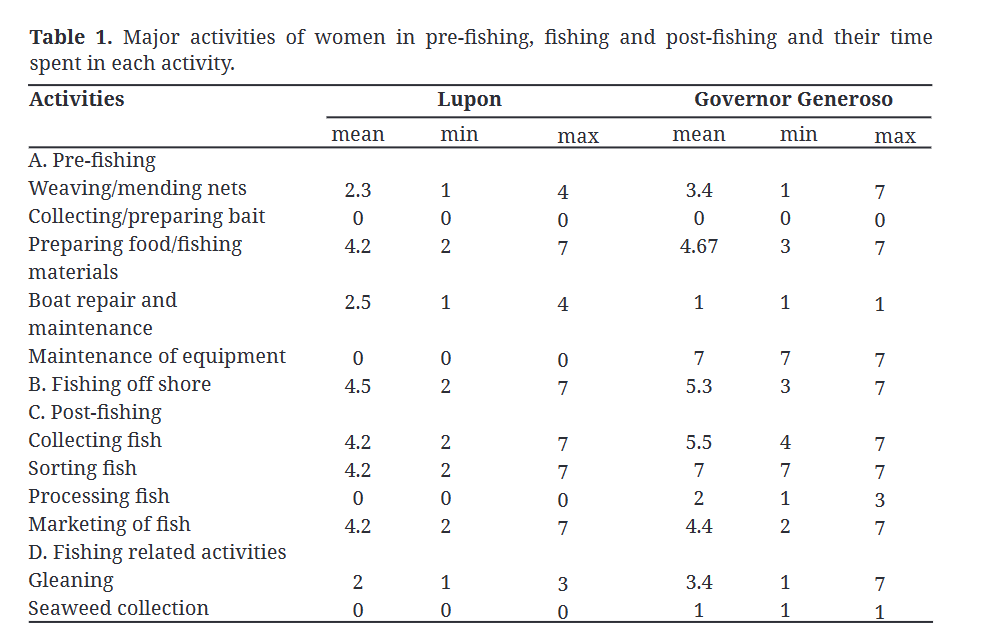 |
|
This table follows the APA format, with no vertical lines to distract the eye and only a few horizontal lines used for headings and the last line. |
Below is an example of another table that contains more horizontal lines for combined information in one table.
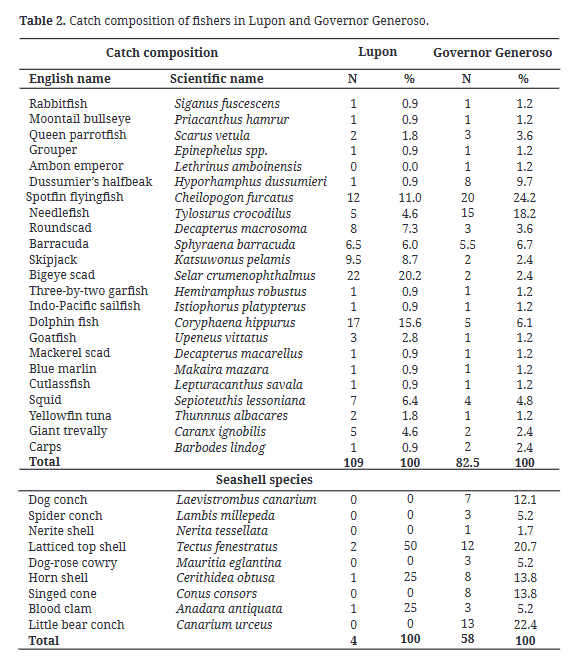 |
|
This is an example of a table that contains more information than the previous one, with two headings: catch composition for fish species and catch composition for shell species. |
Below you can see other examples of a typical figure, which were provided as examples from previous articles published in the DRJ.
|
This is an example of a panel figure where more than one graph is included in one Figure. This is typically used in survey-type or descriptive studies, but also when presenting multiple photos. |
DISCUSSION
A separate Discussion section from the Results section should be followed, where the study's findings are clearly discussed in relation to their broader context in the literature. This is the part where authors must explain their findings or why their study provides better or more novel implications compared to the past. If their research diverges from an accepted hypothesis, they must explain why this difference occurred, distinguishing it from the accepted ones in the literature. It seems that the discussion should be done for integration purposes, i.e., within other results of the study or with reference to earlier studies. Recommendations can be included in the last part of the Discussion section.
CONCLUSION
These should include the summary and implications of the study's findings.
ACKNOWLEDGEMENT
Acknowledgements of people, grants, funding agencies, scholarships, etc., should be included in this section just before the references.
FOUNDING SOURCE
Please specify the entities that funded the study.
CONFLICT OF INTEREST
Statement identifies any circumstances in which an author (or authors) has financial, personal, or professional interests that could affect the outcomes, interpretation, or presentation of the research.
AUTHOR’S CONTRIBUTION
The specific roles and responsibilities of each author in the research process are ensured by transparency and accountability.
REFERENCES
For literature cited, follow the latest APA citation format and cite references in the text by name and year in parentheses. Some examples:
- Negotiation research spans many disciplines (Jimenez, 2006).
- This result was later contradicted by Trangia and Macusi (2023).
- This effect has been widely studied (Zabala 1981; Calvez et al., 1995; Sumile and Ponce 2008; Maynawang et al., 2021).
Reference list
- Authors' surnames are written first, followed by the first letter of the first name and middle initial (if applicable). No comma separates the author's surname and initials.
- Only the first letter of the reference title must be capitalized. Proper nouns and genera of scientific names should also be capitalized.
- Titles are not italicized. However, species names are italicized.
- To save space, journal titles are abbreviated according to the ISO 4 standard. Proper abbreviations for all journals must be used. When the journal is not included in the list, then the journal name must be spelled out. For a complete listing of the standard abbreviations of a journal’s name, please see:
o http://library.caltech.edu/reference/abbreviations
o http://journalseek.net
o List of Title Word Abbreviations at ISSN.org
o http://images.webofknowledge.com/WOK46/help/WOS/J_abrvjt.html

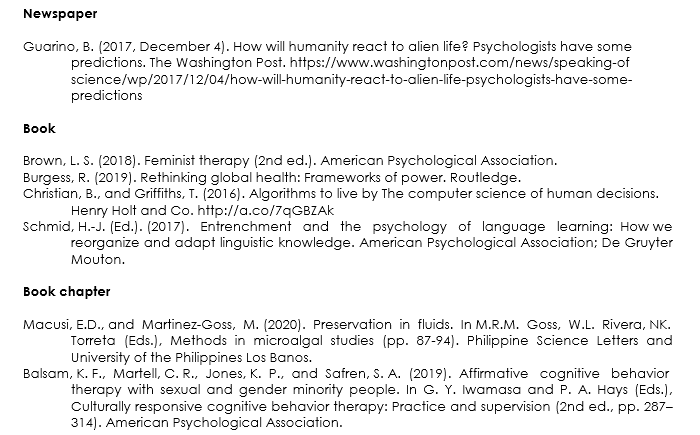
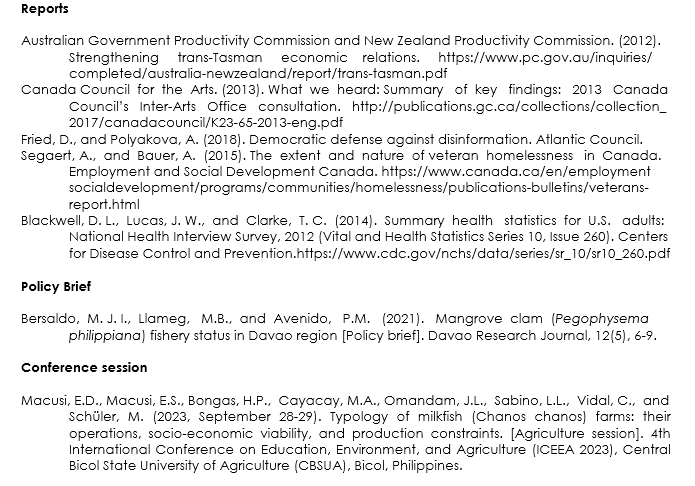
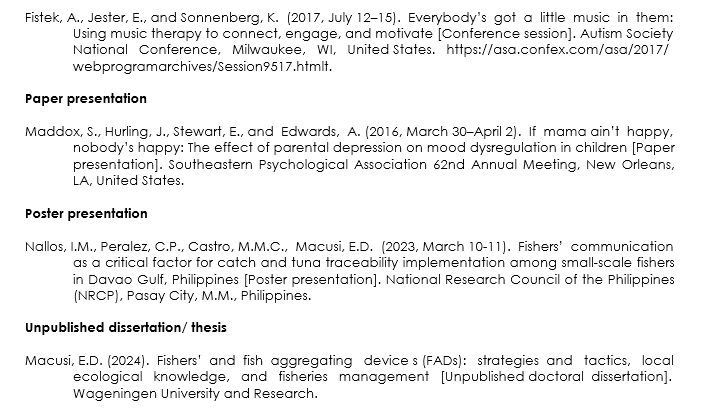
Submission Preparation Checklist
All submissions must meet the following requirements.
- Original research articles must be formatted following the IMRAD format, double-spaced in Times New Roman (font size 12) or Arial (font size 11) ;
- Review articles may not contain a methodology section but they should briefly describe how data was collected and analysed and then discussed.
- Policy briefs should be brief, 1500 words containing an introduction, approach to the problem, and results and then conclusion; it must have minimal tables and figures;
- Research notes must be 2500 words and contain an introduction with a brief description of its methodology, followed by Results and Discussion and no longer than 1 page of references.
- Cover letter, please provide a written email addressed to the Editor-in-Chief why your paper should be considered for publication in this journal;
- Credit Taxonomy, please provide credit roles for all authors included in the study e.g. conceptualization of paper/research, gathering of data, analysis of data, writing of original drafts, review of revised paper, obtaining of funds, use of software, etc.
- List of 5 reviewers who will review your paper but should not be from the same institution where you came from.
Copyright Notice
This is an open-access journal which means that all content is freely available without charge to the user or his/her institution. Users are allowed to read, download, copy, distribute, print, search, or link to the full texts of the articles in this journal without asking prior permission from the publisher or the author.
Privacy Statement
The names and email addresses entered in this journal site will be used exclusively for the stated purposes of this journal and will not be made available for any other purpose or to any other party.





